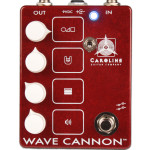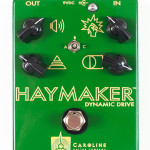Haymaker vs. Wave Cannon v1/Cannonball vs. Wave Cannon MKII?
It’s pretty simple. It’s called marketing. Some people like the same thing with different names because they identify with that name or word more. Consider all the different brands of laundry detergent, shampoo, or non-craft beer out there. Don’t they all share the same active ingredients? Can anyone really tell the differences among them? I mean, really? Are you so sure?
We do look forward to more cross-platform design synergies, the opportunity to monetize public-private partnerships, objectively customize competitive architectures, continually benchmark user-centric AW MAN THIS B.S. IS EXHAUSTING! How do rich dudes in suits do it? How about we just tell you the truth, try not to be too tech-y, and hope this clears it up for you?
 Wave Cannon 1/Cannonball: This was the pedal that got us started in 2010, and it’s based on a classic 1970s DOD OD-250/ Proco Rat style frame: single op-amp pushed really hard, hard clipping to ground, and a discrete transistor buffer between the tone and volume control. We incorporated a variation of a known mod to these kinds of pedals courtesy of Phillip Ruetz that we called the Shape control (named that way because I once saw the actual shape of some treble frequencies I played go from square to sine as we changed the values), and added the feedback loop we called the Havoc control after I did it by accident on the breadboard. If I had known that we’d end up making over 900 of these pedals, I would have done things very differently. Let’s just say it’s not going to win any design awards. It was laid out pretty poorly and they are an inefficient pain in the butt to make. My friend Wes Kuhnley of Resonant Amps once asked me why we used a single op-amp instead of a dual. My answer? When we started making these, I actually didn’t know how to implement a dual op-amp for its design. That being said, these pedals can sound pretty cool, so we’ve continued to make Cannonballs as the legacy of this product and incorporated more mods for fun stuff – stutter switches, different clipping diodes, voltage sag on the chip, and/or adjustable amount of current in the feedback loop. We offer these as limited releases with custom artwork, so if you like that classic, thick sound (Jason Isbell recently turned a lot of folks onto this pedal with a gorgeous Instagram vid) and would like something funky for your board with a couple weird mods, specially painted by an artist friend of ours, a Cannonball might be the ticket.
Wave Cannon 1/Cannonball: This was the pedal that got us started in 2010, and it’s based on a classic 1970s DOD OD-250/ Proco Rat style frame: single op-amp pushed really hard, hard clipping to ground, and a discrete transistor buffer between the tone and volume control. We incorporated a variation of a known mod to these kinds of pedals courtesy of Phillip Ruetz that we called the Shape control (named that way because I once saw the actual shape of some treble frequencies I played go from square to sine as we changed the values), and added the feedback loop we called the Havoc control after I did it by accident on the breadboard. If I had known that we’d end up making over 900 of these pedals, I would have done things very differently. Let’s just say it’s not going to win any design awards. It was laid out pretty poorly and they are an inefficient pain in the butt to make. My friend Wes Kuhnley of Resonant Amps once asked me why we used a single op-amp instead of a dual. My answer? When we started making these, I actually didn’t know how to implement a dual op-amp for its design. That being said, these pedals can sound pretty cool, so we’ve continued to make Cannonballs as the legacy of this product and incorporated more mods for fun stuff – stutter switches, different clipping diodes, voltage sag on the chip, and/or adjustable amount of current in the feedback loop. We offer these as limited releases with custom artwork, so if you like that classic, thick sound (Jason Isbell recently turned a lot of folks onto this pedal with a gorgeous Instagram vid) and would like something funky for your board with a couple weird mods, specially painted by an artist friend of ours, a Cannonball might be the ticket.
 Haymaker: We released Haymaker in 2014 after people asked us to make the overdrive preamp from our Kilobyte® delay into its own pedal. That would have been simple, easy, and easy money. So what did we do instead? We went with a quad op-amp design (I did use a dual for our Icarus™ boost in 2011, so I wasn’t trying to skip any prerequisites or anything), and pursed an idea for an asymmetrical clipping network that would be rotated into different locations in the circuit for different kinds of clipping via the three way mode switch. Haymaker, while sharing the Ruetz-inspired Shape control and a low-pass filter for a tone control, can sound really different from WC1. Mode A/soft clipping has a definitely different feel and even a different EQ response, and Mode B removes all the clipping diodes so the thing really is just overdriving the chip itself, which depending on your amp can either sound like a cranked Sunn Model T being played while being pushed down a flight of stairs, or a very harsh, brittle mess like a Jazz Chorus with slashed speakers – which can be its own kind of cool. Mode C (hard clipping) on Haymaker can be dialed to sound really, really close to most WC1 settings, with plenty of gain available, but it’s not an exact match because of design and component differences throughout.
Haymaker: We released Haymaker in 2014 after people asked us to make the overdrive preamp from our Kilobyte® delay into its own pedal. That would have been simple, easy, and easy money. So what did we do instead? We went with a quad op-amp design (I did use a dual for our Icarus™ boost in 2011, so I wasn’t trying to skip any prerequisites or anything), and pursed an idea for an asymmetrical clipping network that would be rotated into different locations in the circuit for different kinds of clipping via the three way mode switch. Haymaker, while sharing the Ruetz-inspired Shape control and a low-pass filter for a tone control, can sound really different from WC1. Mode A/soft clipping has a definitely different feel and even a different EQ response, and Mode B removes all the clipping diodes so the thing really is just overdriving the chip itself, which depending on your amp can either sound like a cranked Sunn Model T being played while being pushed down a flight of stairs, or a very harsh, brittle mess like a Jazz Chorus with slashed speakers – which can be its own kind of cool. Mode C (hard clipping) on Haymaker can be dialed to sound really, really close to most WC1 settings, with plenty of gain available, but it’s not an exact match because of design and component differences throughout.
Long story short – if you’re not sure which Caroline drive pedal to get, you should probably get this one, because instead of trying to make an overdrive pedal, we’ve decided to make all the overdrive pedals we would make. Including the one from the Kilobyte. It’s in there. Somewhere. Maybe next to the secret wet/dry control inside that we ask you not to touch. Don’t even look.
 Wave Cannon MKII: Using the same quad op-amp from Haymaker, we wanted to do use it for something that would be different from what we’d done before. I wanted more gain than anything we’d offered previously, and an overt “distortion” pedal in this age of more polite drives. So we cascaded gain stages in series to turbocharge things a bit, we kept the symmetrical hard clipping, and added a healthy recovery stage after the different tone controls we used so the thing would still have plenty of volume available (seriously, it kills me how some of my favorite classic distortion pedals from back in the day had LESS volume than their bypass signal, and anyone who tells you differently either plays with the weakest pickups in the world or strums their guitar with juggling scarves). The result is something that is definitely nastier than anything else we make, but also can be really surprisingly good and almost “chimey” at lower gain settings. We called it Wave Cannon® again because we’d basically stopped making WC1s in 2014, and a name like Wave Cannon deserves something that can just be awesome – so that’s why we also called it a Superdistorter. We didn’t want to just make the same pedal we’d done before with a different layout, and we took inspiration from how classic Tone Bender MKI/MKII/MKIII/Jumbo/Super pedals showed evolutionary changes in their design and appearance.
Wave Cannon MKII: Using the same quad op-amp from Haymaker, we wanted to do use it for something that would be different from what we’d done before. I wanted more gain than anything we’d offered previously, and an overt “distortion” pedal in this age of more polite drives. So we cascaded gain stages in series to turbocharge things a bit, we kept the symmetrical hard clipping, and added a healthy recovery stage after the different tone controls we used so the thing would still have plenty of volume available (seriously, it kills me how some of my favorite classic distortion pedals from back in the day had LESS volume than their bypass signal, and anyone who tells you differently either plays with the weakest pickups in the world or strums their guitar with juggling scarves). The result is something that is definitely nastier than anything else we make, but also can be really surprisingly good and almost “chimey” at lower gain settings. We called it Wave Cannon® again because we’d basically stopped making WC1s in 2014, and a name like Wave Cannon deserves something that can just be awesome – so that’s why we also called it a Superdistorter. We didn’t want to just make the same pedal we’d done before with a different layout, and we took inspiration from how classic Tone Bender MKI/MKII/MKIII/Jumbo/Super pedals showed evolutionary changes in their design and appearance.
So while it might be pretty different from what the original was, the MKII is a pedal that incorporates things that I’ve learned and wanted to do. We hope you’ll give it a shot, and not just dial it the way you might with the others, but really explore the controls and potentially find something you just can’t dial up elsewhere. If you want something that can be over the top, is probably differently voiced from other drive pedals you may have, and can still be dialed back, this is the one for you.
